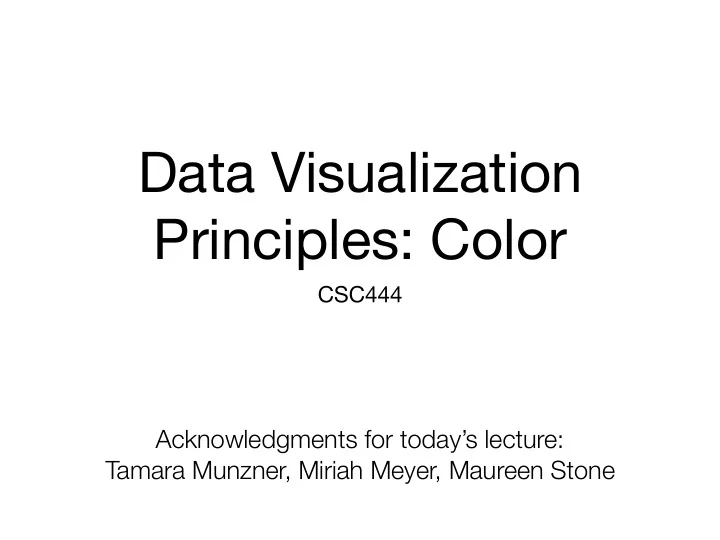

Data Visualization Principles: Color CSC444 Acknowledgments for today’s lecture: Tamara Munzner, Miriah Meyer, Maureen Stone
SOLUTION TO LAST WEEK’S CHALLENGE https://cscheid.net/projects/d3-drills/
RECAP
COLOR SPACES
DEVICE DEPENDENT
RGB • Device-centric • What programs want, not what humans want
HSV • Still device-centric
HSL • Still device-centric • (supported in d3)
DEVICE INDEPENDENT
XYZ Color Space • “Optically linear” • CIE designed three reference spectra: X, Y, Z • Designed so that all visible colors have positive coordinates, and Y is “luminance”
XYZ Color Space Let’s work through this
Lab Color Space • “Perceptually uniform” • Euclidean distance corresponds, roughly, to perceptual distance ( very useful! )
Polar Lab (or HCL) • “Perceptually uniform”, like Lab • Transform ab to polar coordinates: radius is Chroma, Angle is Hue • Conversion to/from RGB is complicated, but distances in HCL make sense, and it makes sense for humans • Like HSV, but good. All else being equal, think HCL first
Demos http://cscheid.net/static/20120216/hsv_frame.html http://cscheid.net/static/20120216/xyz_frame.html http://cscheid.net/static/20120216/luv_frame.html http://cscheid.net/static/20120216/hcl_frame.html
Let’s use consistent names in class Hue Saturation Luminance
CONSEQUENCES FOR DESIGN
“Get it right in black and white” –Maureen Stone
If you’re going to show shape variation, do it with luminance
If you’re going to show shape variation, do it with luminance
If you’re going to show shape variation, do it with luminance
(You can see stars better by looking away from them!)
http://www.settheory.com/Glass_paper/color_motion.gif http://www.settheory.com/Glass_paper/ Kanizsa_observations.html
Do not rely only on hue boundaries to depict shape
Do not rely only on hue boundaries to depict shape
Ware, Chapter 4
Area a ff ects saturation perception Saturation a ff ects area perception
Saturation a ff ects area perception
Area a ff ects saturation perception Saturation a ff ects area perception Imagine the mess if you try to use both…
Simultaneous contrast is a problem Quantize the plot if background is non-constant (This comes at a fidelity cost for the data)
“Categorical” data • Sometimes there’s no implied relationship between di ff erent levels of a variable • Stimuli must look di ff erent, but “ only di ff erent” d3.scaleOrdinal(d3.schemeCategory10)
Order these colors!
You can’t… Order these colors!
Order these colors!
You can’t help but… Order these colors!
You can’t help but… Order these colors!
Be aware of implied and perceptually forced color relationships For categorical data, use color only when you have few categories (less than 10)
The Dreaded Rainbow Colormap
If you need going to use the rainbow colormap, use an isoluminant version, quantize it, or both Bad Better
Infovis 2011
Borkin et al., Infovis 2011
Borkin et al., Infovis 2011 Colormap design matters very strongly
COLORBREWER
COLORGORICAL
Recommend
More recommend